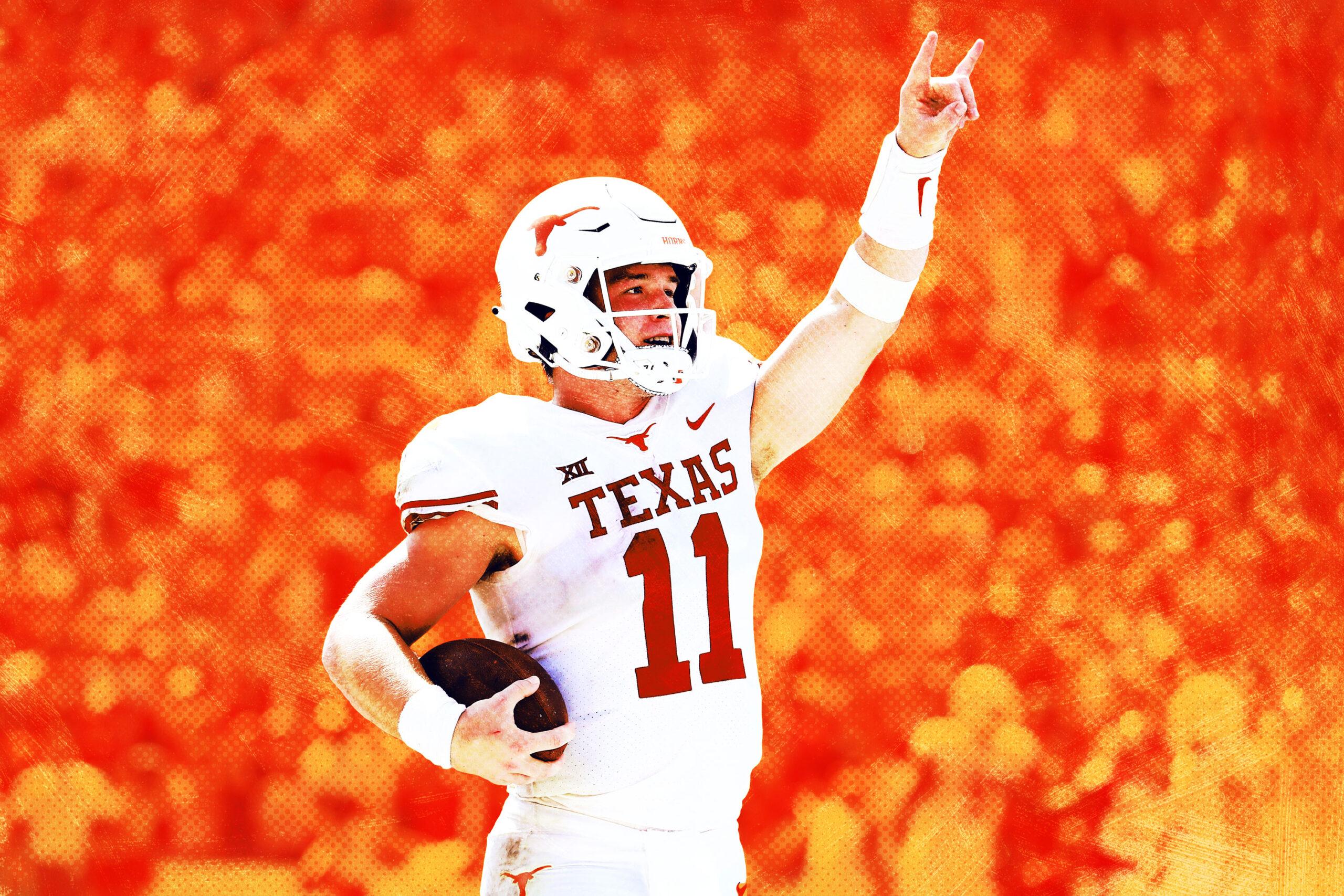Texas Waited a Decade for Sam Ehlinger. Can the QB Push the Longhorns Over the Top?
From Garrett Gilbert to David Ash and beyond, Texas football has long waited for a quarterback to lead it back to the promised land. This time seems different—and Ehlinger isn’t shying away from the expectations.
The University of Texas football team has long lived and died with its quarterbacks. The Longhorns were a perennial force in the mid-to-late 2000s behind Vince Young and Colt McCoy and have languished in the 2010s while failing to find a worthy successor at the position. Texas has always had the caliber of athletes necessary to compete with any team in the country. It just needed the right QB to push it over the top.
At long last, the search appears to be over. Sam Ehlinger, a local product who attended the same Austin high school as Drew Brees and Nick Foles, put the program back on the map last season by delivering its first 10-win campaign of the decade. If the Longhorns take the next step and emerge as national championship contenders this fall, it’ll be because the 6-foot-3, 230-pound junior led them there. Plenty of would-be saviors have passed through Austin over the past decade, from Garrett Gilbert to David Ash to Jerrod Heard. This time seems different. Not only is Ehlinger more well-rounded than any of his predecessors, but he’s also playing in a system perfectly tailored to his strengths.
Ehlinger came to Texas as the most highly touted recruit in head coach Tom Herman’s first signing class. But nothing was handed to him when he arrived on campus. The QB originally split time with Shane Buechele, who showed flashes of potential while starting for Texas as a true freshman. Ehlinger struggled with accuracy in 2017, completing 57.5 percent of his passes. He was deployed primarily as a runner as the Longhorns went 7-6.
The team’s fortunes changes last season when Ehlinger made a quantum leap. He showed far more sophistication as a passer in his second season in Herman’s scheme. Ehlinger always had the arm strength to chuck the ball down the field, but became far more comfortable making intermediate throws too. The difference between his freshman and sophomore season passing stats is dramatic:
Ehlinger’s Numbers by Season
While Ehlinger was a long way from being as effective as Alabama’s Tua Tagovailoa or Clemson’s Trevor Lawrence—the presumptive no. 1 picks in the 2020 and 2021 NFL drafts, respectively—that didn’t stop him from leading the Longhorns past elite competition. Texas went 2-2 in games against Oklahoma and Georgia over the past two seasons, with Ehlinger’s ability to dictate the action through the air and on the ground evening the odds with his more heralded peers. Ehlinger outdueled Kyler Murray, who had arguably the greatest passing season in NCAA history, in the Red River Rivalry before losing the rematch in the Big 12 championship game. And Ehlinger joined Marcus Mariota as the only Division I quarterbacks since 2000 to record 25 passing touchdowns, 15 rushing touchdowns, and five or fewer interceptions in a season.
Two things make Ehlinger special. The first is his size. He’s built more like a linebacker than a quarterback, and his frame makes him nearly impossible to stop when he carries the ball in short-yardage situations. Ehlinger wasn’t a big-play threat as a runner in 2018; he rushed for 482 yards and averaged 2.9 yards per carry. His job was to move the chains and punch it in when Texas got close to the goal line.
The second is his decision-making ability. Ehlinger simply doesn’t make many mistakes. He was tied for the third-fewest interceptions (five) among the 107 NCAA QBs who averaged at least 14 passing attempts per game last season. More strikingly, he didn’t throw a pick for two months between mid-September and mid-November. He eventually earned enough trust that he was given the freedom to change play calls at the line of scrimmage.
That combination of traits makes Ehlinger a first-down machine. A QB who hardly ever turns the ball over and is automatic in short-yardage situations is almost impossible to get off the field. The Longhorns weren’t an explosive offense last year—they didn’t have a single play longer than 50 yards—but they were methodically effective, marching up and down to wear out defenses. They ranked 58th in the FBS in yards per game, but 12th in first downs.
That held true in the Sugar Bowl, when they maintained possession for 35 minutes in a 28-21 upset victory over Georgia. Ehlinger went 19-for-27 for 169 yards in that game; more notably, he carried 21 times for 64 yards and three touchdowns. Few saw it coming. A Big 12 QB isn’t supposed to be able to punch an elite SEC defense in the mouth. Ehlinger’s physical dominance in New Orleans was just as big a statement as the one he made after the game, when he famously declared that Texas was back.
Ehlinger will get another chance to make a statement against a perennial SEC powerhouse early in 2019, when Texas hosts LSU on September 7. The schedule sets up well for the Longhorns: They leave their home state only twice all season. As always, their hopes will rest on their midseason clash with Oklahoma. Only this time, the Sooners will be without Baker Mayfield or Kyler Murray; for once, the Longhorns could have the edge at QB.
One of the biggest challenges for Texas will be keeping Ehlinger healthy for a full season, given all the hits he takes. He missed time in each of his first two seasons with various nicks and bruises. And now Texas can no longer rely on Buechele as a backup QB. He transferred to SMU, leaving a redshirt freshman (Casey Thompson) and a true freshman (Roschon Johnson) as the only other scholarship QBs on the roster.
Texas has other key playmakers to whom it can turn. Two to monitor are sophomore running back Keaontay Ingram, who rushed for 708 yards on 5.0 yards per carry last season, and senior wide receiver Collin Johnson, whose size (6-foot-6, 220 pounds) and sure hands make him almost unguardable in one-on-one situations.
And while the Longhorns lost eight defensive starters from the 2018 squad, they should have no problem reloading on that side of the ball. They signed the no. 3 recruiting class in the country in each of the past two years, per the 247Sports composite rankings. The cream usually rises to the top in college football: Banner Society’s Bud Elliott tracks every FBS program’s “blue-chip ratio” (the percentage of a roster composed of consensus four- and five-star recruits) and found that no national champion since the turn of the century had a roster with a ratio below 50 percent. Texas, which checks in at 60 percent in 2019, is well above that threshold.
But talent alone isn’t always enough. The underlying issue at Texas over the past decade goes beyond wanting QB play. The Longhorns also haven’t had coaches who could put their QBs in positions to succeed. Namely, they failed to keep up with the innovation happening all around them.
The offensive revolution that has recently taken hold in the NFL happened at Texas high schools a long time ago. The Air Raid offense won the broader philosophical struggle in the state even before Mike Leach was forced out of Texas Tech in 2009, and now the Texas state playoffs are typically won by schools whose offense can best imitate his. But longtime coach Mack Brown failed to adapt toward the end of his 16-year tenure, and successor Charlie Strong came from a background that used a pro-style scheme. Strong tried to install the same offense at Texas with disastrous results, cycling through three coordinators over three seasons before being fired in 2016.
The result was a bizarre dichotomy. Texas is a breeding ground for NFL quarterbacks, with 18 in training camps this season. But the state’s flagship university couldn’t find a competent one. Only two of those 18 (McCoy and Gilbert) played for the Longhorns, and Gilbert’s college breakthrough happened only after he transferred to SMU. UT was a man dying of thirst in the middle of the ocean: There was water all around, but none to drink.
That’s changed under Herman, who has spent his whole coaching career running the spread offense. He was a Longhorns graduate assistant under Brown, then spent 10 more seasons working at colleges in the state. He made his name as the offensive coordinator for the Ohio State team that won the 2014 national title behind a third-string QB. Herman went 22-4 in two seasons as the head coach at Houston before taking over at Texas in 2017.
Ehlinger is in the right place at the right time. Unlike his predecessors, he runs the same type of spread offense in college that he grew up with. He has a strong grasp of how to maximize the system and a stronger supporting cast. And now that Texas is apparently back, lofty expectations are too: The Longhorns are ranked no. 10 in the AP poll.
This could be the start of something special in Austin. Ehlinger has grown so much in his first two seasons under Herman that it’s hard to put a ceiling on how good he could be after two more. It’s a perfect marriage between a QB from Austin and a coach who began his career there. All Texas had to do to get back to the top was go back to its roots. Given Austin’s reputation, it’s fitting that its football team’s resurgence is locally sourced.

